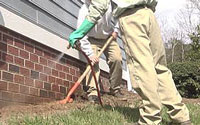It`s that time of year here on Long Island: Termite season! Their swarming season typically begins in late March and early April and can last though May or early June. The subterranean termites will swarm typically during mid day, when it`s sunny, and usually following rain.
Although termites are active year-round, they are less active during the winter and summer months as they will not forage when the soil is too hot or too cold. Here on Long Island, our spring season is the perfect season for termite activity. Unfortunately, not all homeowners know that they need to protect themselves from infestation. The reality is that the question isn`t if you have termites, but when you will get them. It is during this season that termites will begin to swarm, which is the most obvious sign that you have a termite problem.
What is a Termite Swarm:
Spring time is when termites will go airborne in order to reproduce. This is what`s known as “swarming.†Termites will leave their colonies to mate and produce new colonies. Unfortunately, seeing a swarm is usually the way homeowners realize they have a termite problem. But when termites are swarming, this means that the colony has matured and damage is already occurring.
Signs Of Termite Infestation:
Dead Termites-
Finding wings or dead termites around your windows, doors, heating vents, and other places are a sign of termite activity.
Damaged Wood-
This may be difficult to detect at the beginning of an infestation because termites typically feast on wood from the inside out. Wood that sounds “hollow†should be inspected for termite damage.
Mud Tubes-
These are easy to spot as they look exactly like what their name is: tube of mud. They can be found on walls on the inside or outside of your home or any other wood structure. The mud tubes can be round or flat and usually measures 1/4″ or wider.
Tips To Prevent Termite Infestation:
1. Look out for mud tubes or termite wings. These are warning signs that termites are present.
2. Keep moisture and condensation away from the home`s foundation, such as from an air conditioner.
3. Stack your firewood and other lumber far from your home.
4. Eliminate the use of wood mulch around the foundation or at least change it often.

